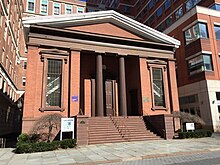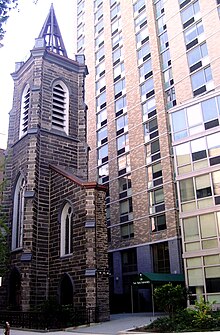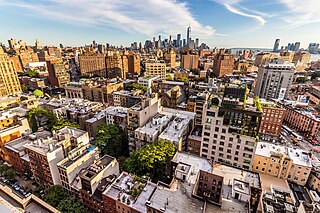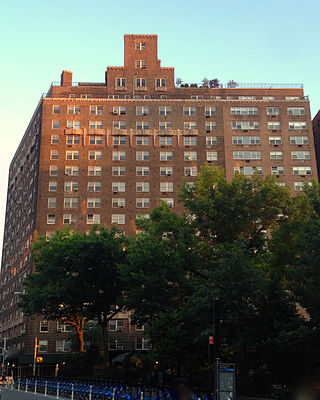Washington Square campus
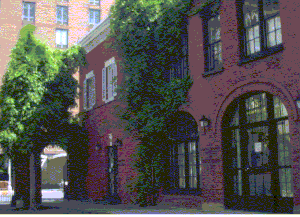
Most of NYU's buildings on the main campus are scattered across a roughly square area bounded by Houston Street to the south, Broadway to the east, 14th Street to the north, and Sixth Avenue (Avenue of the Americas) to the west. Most of NYU's main buildings, including the Silver Center, Elmer Holmes Bobst Library, Stern School of Business, Courant Institute of Mathematics, and the Kimmel Center, surround Gould Plaza and Washington Square Park.
Since the late 1970s, the central part of NYU is its Washington Square campus in the heart of Greenwich Village. Despite being public property, and expanding the Fifth Avenue axis into Washington Square Park, the Washington Square Arch is the unofficial symbol of NYU. Until 2008, NYU's commencement ceremony was held in Washington Square Park. However, due to space constraints, ceremonies are now held at the Yankee Stadium. Important facilities at Washington Square are the Elmer Holmes Bobst Library, designed by Philip Johnson and Richard Foster, who also designed several other structures, such as Tisch Hall, Meyer Hall, and the Hagop Kevorkian Center. When designing these buildings Johnson and Foster also set up a master plan for a complete redesign of the NYU Washington Square campus. However, it was never implemented. Other historic buildings include the Silver Center (formerly known as "Main building"); the Brown Building of Science; Judson Hall, which houses the King Juan Carlos I of Spain Center; [2] Vanderbilt Hall, the historic townhouse row on Washington Square North; The Grey Art Gallery at 100 Washington Square East, housing the New York University art collection and featuring museum quality exhibitions; [3] [4] the Kaufman Management Center; and the Torch Club – the NYU dining and club facility for alumni, faculty, and administrators. Just a block south of Washington Square is NYU's Washington Square Village, housing graduate students and junior and senior faculty residences in the Silver Towers, designed by I. M. Pei, where an enlargement of Picasso's sculpture Bust of Sylvette (1934) is displayed.
The contractors of the Old University Building used prisoners from Sing Sing to cut the marble. This hiring was the catalyst for the famous Stonecutter's Riot. The old University Building was also subject to several ghost stories. It was believed that the building was haunted by a young artist resident who had died in one of the building's turrets. The spirit was said to pace through the hallways and staircases. In 1880, the San Francisco Chronicle reported that "the structure has an evil repute with the servant girls of the neighborhood ... They have a notion that deep in subcellars lie corpses, skeletons and other dreadful things." [5] The Triangle Shirtwaist Factory fire on March 25, 1911, took place in the Brown Building of Science (formerly the Asch Building) which today is part of the NYU campus. More than a hundred garment workers, most young women and girls, died or jumped to their deaths after a fire broke out whilst all exit doors were locked. The fire led to legislation requiring improved factory safety standards and helped spur the growth of the International Ladies' Garment Workers' Union.
In the 1990s, NYU became a "Two Square" university by building a second community around Union Square, about a 10-minute walk from Washington Square. NYU's Union Square community consists of the upperclassmen residence halls of Carlyle Court, Palladium Residence Hall, University Hall, Alumni Hall, Coral Towers, Thirteenth Street Hall, and Third North Residence Hall.
NYU theaters and clubs
NYU operates several theaters and performance facilities that are often used by the university's music conservatory and Tisch School of the Arts but also external productions. The largest performance accommodations at NYU are the Skirball Center for Performing Arts (850 seats) at 566 LaGuardia Place, just south of Washington Square South; and the Eisner-Lubin Auditorium (560 seats) in the Kimmel Center. Recently, the Skirball Center hosted important speeches on foreign policy by John Kerry [6] and Al Gore [7] as well as the recording of the season finale of The Apprentice 3. Well-known also is NYU's Provincetown Playhouse on MacDougal Street, where Eugene O'Neill among many others launched his career and the Frederick Loewe Theatre outside Gould Plaza. Catalyst to many careers in music (Bruce Springsteen began his career here among many others) was the famous nightclub The Bottom Line, found on the corner of West 4th and Mercer Streets. Despite the objections of many supporters, this club was evicted by NYU after being unable to meet for several months the increased rent payments.
Bobst Library
The Elmer Holmes Bobst Library, built between 1967 and 1972, is the largest library at NYU and one of the largest academic libraries in the U.S. Designed by Philip Johnson and Richard Foster, the 12-story, 425,000 square feet (39,500 m2) structure sits on the southern edge of Washington Square Park and is the flagship of an eight-library, 4.5 million volume system that provides students and faculty members with access to the world's scholarship and serves as a center for the University's intellectual life. Bobst Library contains more than 3.3 million volumes, 20,000 journals, and more than 3.5 million microforms. The library is visited by more than 6,500 users each day, and circulates almost one million books annually. [8] In addition to its regular collection it houses a number of special collections and archives, including the Archives of Irish America and the Tamiment Library and Robert F. Wagner Archives.
The floor of the library, when viewed from above, was designed to appear three-dimensional. In late 2003, Bobst Library was the site of two suicidal incidents. Two students jumped from the open-air crosswalks inside the library onto the marble floor below. The students later died of their injuries. [9] After the second suicide, NYU installed plexi-glass windows on each level to prevent further attempts. In 2003, Bobst Library was also in the news for being the home of a homeless student who resided at the library because he could not afford student housing. [10] Broke student 'slept in library'
Real estate and development
Greenwich Village has long had a mixed relationship with NYU. Residents and university leaders frequently have differing views on how the school, its buildings and its students should interact with the neighborhood. [1]
The tearing down of a block of tenements and brownstones in 1950 for construction of Vanderbilt Hall, the law school, was a signal of things to come. Residents both mourned the loss of the old block, on Washington Square South between MacDougal and Sullivan Streets, and worried about the university dominating the Washington Square area. [11] Following the closure of the Bronx campus (see History section above), the school expanded downtown, growing significantly – both in student body size and academic and dormitory footprint – from the 1980s through the present. [1]
In addition to the sheer mass of the school's real estate holdings, its approach to architecture has often been criticized. From 1964, when noted architecture critic Ada Louise Huxtable wrote that NYU had a "consistent blindness to the area's architectural and historical features", [12] to 2013, when critic James Russell wrote that "for decades, New York University has waged architectural war on Greenwich Village", [13] the school has developed a reputation for construction that is insensitive to both aesthetic and community concerns.
While the Bobst Library, built in 1973, and the many dorms built throughout the 1980s and 1990s all had their detractors, construction of the Kimmel Center for University Life (opened 2003) on Washington Square South sparked broader attention. Critics said the building would ruin the Fifth Avenue view through the Washington Square Arch and cast a shadow on the park, issues impacting a broader swath of city residents and tourists. Over the years, a local preservation group, the Greenwich Village Society for Historic Preservation (GVSHP), has been a vocal opponent of NYU. [14] GVSHP was one of several dozen participants, including NYU itself, in the Community Task Force on NYU Development, which was convened by Manhattan Borough President Scott Stringer in 2006. "In order to maintain the integrity of the affected neighborhoods, the University's goals for growth and development must be better aligned with those of the community at large" stated the Findings and Recommendations report of March 2010. [15] Controversies in recent years include:
- Edgar Allan Poe house – As the university contemplated new construction to expand its law school, preservationists called for protection of 85 West Third Street, where Poe lived from 1844 through early 1846. It is where he wrote "The Cask of Amontillado" and revised and published "The Raven". They asked the Landmarks Preservation Commission to protect the building, but it did not, so they also filed suit to save it. NYU officials said they did not consider the Poe house, or the Judson House on the same block (between Sullivan and Thompson Streets), important enough to save. [16] Both were razed for construction of Furman Hall. Although NYU promised to incorporate a rebuilt Poe House into the new building, using original materials, officials eventually claimed not to have enough bricks to do so, and preservationists said the antique simulacrum revealed in 2003 did not resemble the razed building. [17]
- St. Ann's Church – An unusual-looking high-rise in the East Village – the neighborhood's tallest – is a symbol of another conflict between the school's plans and residents' desires. On the site of the demolished St. Ann's Church on East 12th Street between Third and Fourth Avenues, the university planned to build a dorm and solicited community input on its plans. The community asked that the 240-foot-tall building be scaled back, only to find in 2006 that construction plans were moving ahead to build a 26-story dormitory. That building, Founder's Hall, now towers over one preserved wall of the former St. Ann's Church, the gray stone façade facing E. 12th Street. [18]
- Provincetown Playhouse and Apartments – Located at 133-139 MacDougal Street, this four-story complex hosted performances of works by playwrights from Edna St. Vincent Millay to Eugene O'Neill to Sam Shepard in its playhouse, while artists and others found shelter in the apartments above. In 2008 the school proposed to demolish the entire building and rebuild a facility for the law school, as well as a new theater. [19] The same year, the New York State Office of Parks, Recreation and Historic Preservation responded positively to GVSHP's request that the building be found eligible for listing on the State and National Registers of Historic Places. In the face of community opposition, NYU agreed to preserve just six percent of the old building: the walls containing the small theater in the southern corner of the building. However, during construction, behind construction barriers and invisible from the street, NYU secretly tore down parts of the walls they promised to preserve, a fact publicly revealed by GVSHP. [20]
- NYU 2031 – This ambitious plan for the university's expansion was met by wide resistance both among unaffiliated city residents, and among university faculty and staff. [21] Not only did community members consider the plan itself an abrogation of the "Planning Principles" that came out of the Community Task Force, but a new group formed called NYU Faculty Against the Sexton Plan (NYU FASP). When the city approved the 2031 plan, FASP, GVSHP and others filed suit to stop it. In January 2014, State Supreme Court Justice Donna Mills halted the plan based on illegal takings of parkland, but NYU appealed. [22]
Recent construction
Over the last few years, NYU has developed a number of new facilities on and around its Washington Square campus.
The Kimmel Center for University Life, named for benefactors Helen and Martin Kimmel, was built in 2003 to house the majority of the University's student services offices. The center also houses the Skirball Center for the Performing Arts, the Rosenthal Pavilion, the Eisner & Lubin Auditorium, and the Loeb Student Center. The Jack H. Skirball Center for the Performing Arts is a professionally operated and programmed 850-seat proscenium theater. Presentations there have included the Abbey Theater of Dublin's Playboy of the Western World, the world premiere of Mabou Mines Red Beads, a series of concerts by World Music Institute, and a series of superlative dance companies, including Lar Lubovitch and Bill T. Jones. The Skirball Center is the largest performing arts facility south of 42nd Street. [23]
The School of Law's Furman Hall, built in 2004, was named for NYU Law alumnus Jay Furman (JD '71). Rebuilt elements of two historic buildings were incorporated into the new facade, one of which was occupied by poet Edgar Allan Poe. [24]
In 2005, NYU announced the development of a new life science facility on Waverly Place. The facility will accommodate laboratories and related academic space for the life sciences and will be the first NYU science building developed since the opening of Meyer Hall in 1971. [25]
In November 2005, NYU announced plans to build a 26-floor, 190,000-square-foot (18,000 m2) residence hall on 12th Street. The residence hall is expected to accommodate about 700 undergraduates and contain a host of other student facilities. It is to be the tallest building in the East Village. [26] The plans have caused anger among East Village and other New York City residents, as the new building would be built over the old St. Ann's Church. [27] Following construction, the new residence hall was named Founders Hall.
A new $1.3 billion building will replace the Coles Sports and Recreation Center at 404 Lafayette Street formerly located on the site. The building, set to open in 2021, will include a gym, a swimming pool, three theaters and class rooms. It will be topped by two towers with faculty and student housing. [28]
